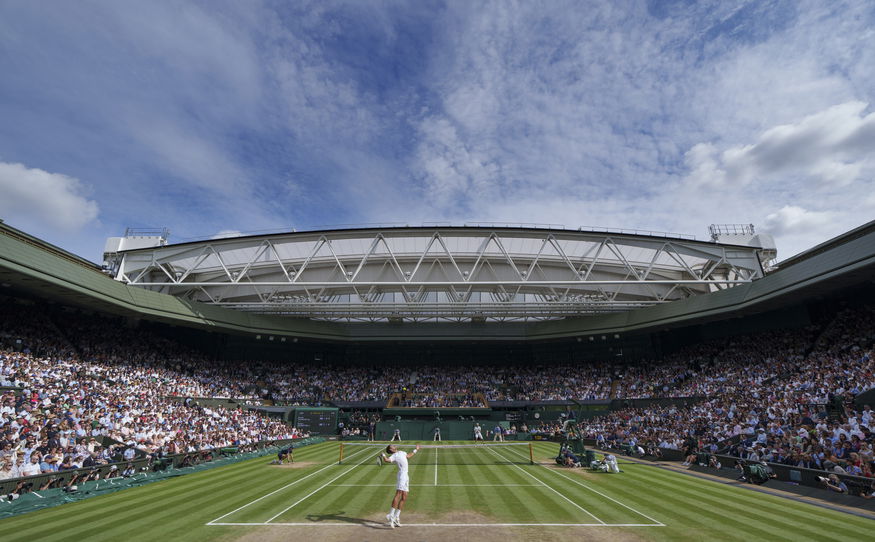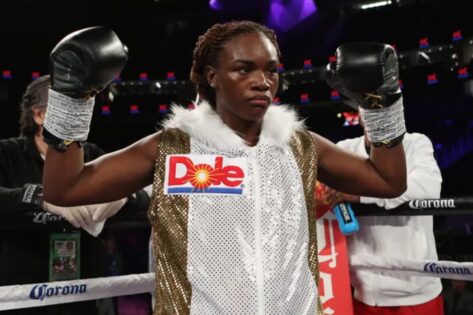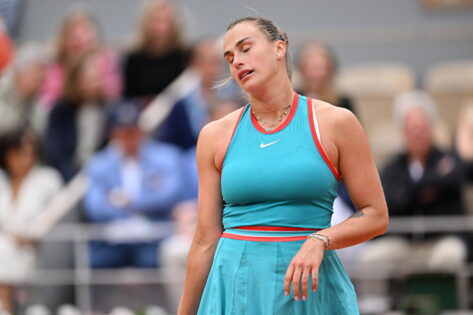The sun may have set on the 2025 Wimbledon tournament, but there’s still plenty to talk about! Nearly 23 of the 64 seeded players fell in the first round. Meanwhile, Iga Swiatek whisked away the women’s Venus Rosewater Dish. On the men’s side, Jannik Sinner toppled the two-time defending champion to claim his first Wimbledon title. It’s been a rollercoaster of a fortnight, to say the least. Here’s everything that went down amid the intense competition!
London heat takes a hit on players and spectators!
The tournament blasted off with a sizzle as temperatures hit 29.7°C (85.5°F), smashing a 2001 record. The heat wasn’t just brutal—it paused matches, like when Carlos Alcaraz stopped after an elderly fan fainted, even handing her water himself. Aryna Sabalenka and Taylor Fritz faced similar heat drama. Iga Swiatek kept it light, posting a sweaty cloth toss on Instagram with, “@wimbledon what’s with this weather? London, is that you?” Definitely not the usual British summer vibe.
Players didn’t hold back on the heat complaints. Germany’s Eva Lys said, “Tough. Really, really tough. I think one thing that really helped me is to know my opponent has the same situation as me. I was sweating a lot, so my racket was very slippery.” Meanwhile, doubles champ Taylor Townsend joked, “Of course we decide to take the tube when it’s 88 degrees outside.” The heat wasn’t just on Centre Court—it was a stamina crusher everywhere.
July 2, 2025, London, Celestynow, England: IGA SWIATEK of Poland during the match against P. Kudermetova in the first round of Championships 2025 at Wimbledon AELTC in London. London England – ZUMAc278 20250702_zsp_c278_011 Copyright: xMarcinxCholewinskix
Carlos Alcaraz summed it up after his semifinal: “It was a really difficult match. Even tougher with the conditions. It was really hot again. With the pressure of a semi-final it was not easy. I was just really proud how I stayed calm, thinking clearly.” But the heat was only part of the story—players faced plenty more challenges this tournament.
Players call out fatigue amidst Wimbledon hype
From Swiatek to Alcaraz, players are sounding the alarm on tennis’ relentless schedule. At Wimbledon, Novak Djokovic laid it bare. Asked why so many players feel burnt out or turn to antidepressants, he said, “Tennis has the longest season of all global sports . For most who play the full schedule, it’s from January 1 to late November. Other sports have more competitions now too, but tennis is individual — there are no substitutes.” With over 70 tournaments in 2024 stretching almost 11 months, Djokovic added, “If you want to reach the highest heights, you have to transform your entire life in service of tennis and sport. You lose yourself…”
Additionally, Wimbledon has no plans to stretch its famous two-week run into a 15-day event, with former British No. 1 Tim Henman saying organisers have “zero appetite” for such a change. While the U.S. Open just extended its main draw to 15 days and the Australian Open followed suit this year—plus the French Open’s switch to a Sunday start back in 2006—Wimbledon wass standing firm.
The main reason? Preserving the delicate natural grass on Centre Court, which can look pretty battered by the time the finals roll around. But that might not be the only thing bothering players.
Spectators at Wimbledon cause an expensive interruption
If you haven’t heard, Wimbledon runs on strict rules that spectators must follow to keep the vibe classy and respectful. Known for its traditions and etiquette, the tournament expects fans to be on their best behavior. The golden rule? Silence during points, with applause and cheering saved for changeovers or after a point finishes. But this year, there’s a new addition: no popping champagne during the serve!
During the ATP and WTA finals, both Jannik Sinner and Amanda Anisimova had their serves interrupted by champagne corks flying. At Sinner’s match, a cork landed right by his feet, sparking frustration from Carlos Alcaraz and boos from the crowd. Sinner joked it “only happens at Wimbledon,” calling it an “expensive tournament.” Meanwhile, Swiatek, fresh off her women’s final win, vented her annoyance at the press conference: “I’m always going to remember the opening of champagne bottles between serves. It’s a sound that will keep me up at night.”
The champagne chaos wasn’t the only hiccup this year. The tournament also faced backlash for some of its shakeups, stirring the pot among fans and players alike.
Players shared mixed reactions to new line-calling system at Wimbledon
The tournament made a bold move this year, ditching line judges after 148 years in favor of an electronic line-calling system. But not everyone’s buying it. Anastasia Pavlyuchenkova, clearly fed up during her fourth-round match, told umpire Helwert, “I don’t know if it’s in or it’s out. How can I know? You cannot prove it. Because she is local, they can say whatever. You took the game away from me. They stole the game from me. They stole it.”
The human touch is sorely missed by many. Karen Khachanov said, “I’m more for line umpires, to be honest. You feel a little bit the court is too big, too alone without line umpires.” He added, “Looks like AI and electronic line calls has to be very precise and no mistakes, but we’ve seen a couple. That’s questionable why this is happening.” Meanwhile, Cameron Norrie chimed in, calling the new tech “cool” but lamenting the loss of tradition and the people who make the game special.
Add to that, Frances Tiafoe put it perfectly: “I actually like [it] with them [line judges] on the court, because I think for fanfare it’s better. If I were to hit a serve on a big point, you go up with the challenge, is it in, is it out? The crowd is, like, ‘ohhh’. There’s none of that.” Sure, the tech is slick, but for many players, it just doesn’t spark the same magic. Just like another issue the players faced.
Wimbledon’s grass court receives harsh remarks this year
This event’s charm has always been its iconic grass courts, a tradition dating back to 1877. Back then, the wild turf favored serve-and-volley players with its fast, unpredictable bounce. But in 2001, a switch to 100% perennial ryegrass brought a more durable, slower surface. This change made rallies longer and shifted playing styles—but not everyone is convinced it’s for the better.
Defending women’s champ Barbora Krejcikova wasn’t shy about her thoughts after her opening win against Alexandra Eala. “There’s not enough water, and it gets really, really yellow, very, very fast,” she said. “I think with the heat, yes, the grass is more like stopping. The game is just different [to] what you are normally used to.” Canadian Denis Shapovalov was even more blunt: “The balls are the worst, the grass tour has turned into a joke. This isn’t grass anymore, the court is slower than a clay one. It’s not even grass.”
Two-time Wimbledon winner Petra Kvitova noticed the change too. “I’m not sure if it’s only grass,” she said. “Maybe it’s the balls, as well. Overall it’s getting slower.” American third seed Jessica Pegula agreed the courts “felt different” but reminded fans, “That’s grass – they’re all kind of different. It’s a living surface, they’re not going to play the same.” Even Iga Swiatek felt the courts slowing down and the “ball bounced differently” in the heat but expects things to shift. “With the change of the weather we will have to adjust every day to the different conditions,” she said.
So there you have it! While Wimbledon dazzled this year, it faced its share of challenges. Will next year bring improvements? Time will tell! And hey, if we missed anything or you agree, we’d love to hear your take!
The post Iga Swiatek Leads as Five Major Concerns Raised by Tennis Stars at Wimbledon appeared first on EssentiallySports.



